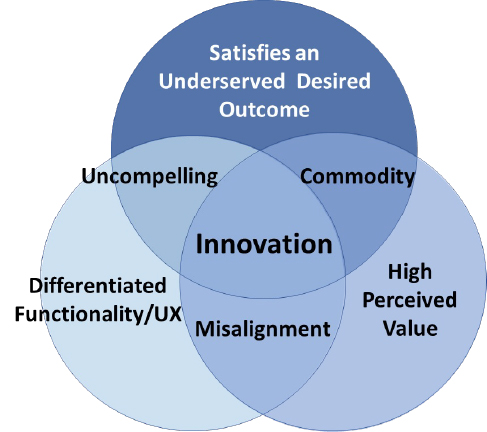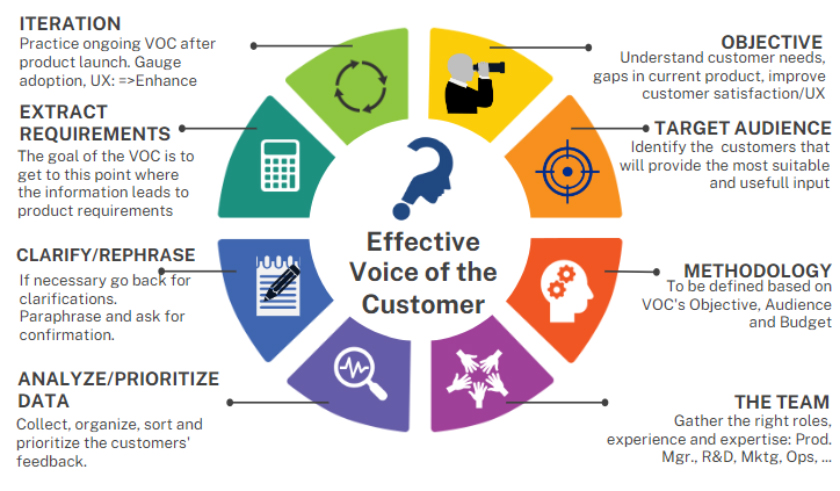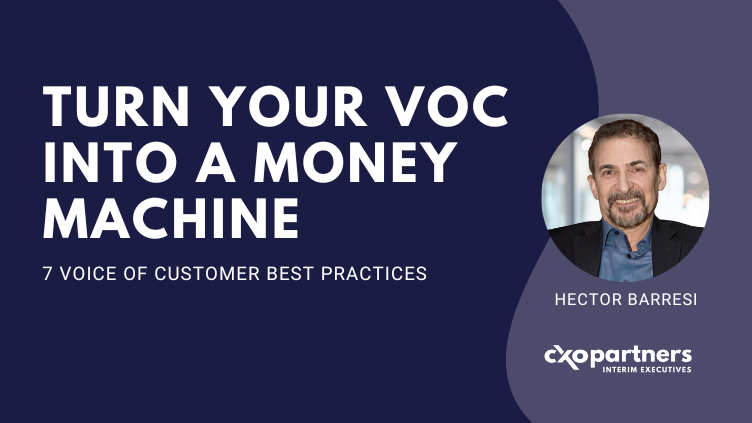In today’s challenging business climate, companies are facing longer sales cycles and the looming shadow of a potential recession, and it’s more important than ever to stay ahead of the competition and find ways to differentiate ourselves in the marketplace. To achieve this, businesses need to listen to their customers and incorporate their feedback into product development processes. This process is known as the voice of the customer (VOC). In this article, we will discuss the seven best practices that businesses can adopt to drive revenue growth through effective VOC to develop innovative products.
VOC is not a new concept; however, it has been evolving throughout the years. Four important trends have emerged in the evolution of VOC: a shift towards customer outcome focused research, increased interaction during interviews, improvements in identifying and addressing misleading data, and a more effective approach to analyzing data and turning it into useful information for the R&D department. These trends enable companies to create truly differentiated, innovative, and higher-value new products that meet the needs of their customers more closely and more effectively than before.
Also, as part of the product’s Go to Market plan, that some VOC information can be used to create a targeted marketing campaign that resonates with customers, increasing the likelihood of a successful product launch.
Before digging into the best process to conduct a truly effective Voice of The Customer process, let’s define how high value Innovation is achieved.
Successful (innovative) new products share three key characteristics:
- They satisfy an underserved outcome need for the customer, meeting a need that is currently unaddressed in the market.
- They offer differentiated functionality and user experience that surpasses that of existing products, including those from the competition.
- They offer a compelling value proposition, meaning that the combination of benefits and price makes the product an irresistible offer for customers.
Measurable innovation requires a holistic approach that encompasses these three key elements. Any gaps can impede innovation and limit a company’s ability to meet its customers’ evolving needs. By aligning the VOC program with the three key elements of innovation, companies can unlock the full potential of the VOC and use it to drive measurable innovation to gain a competitive advantage, stand out in the marketplace, and drive business growth faster.

Here are the 7 Best Practices that will turn your VOC into a Money Machine
- Define the objective of VOC from the Customer’s shoes: The first step in leveraging VOC to drive revenue growth is to define the objective of the process. This involves setting clear goals and objectives for the VOC program, such as understanding customer needs, identifying gaps in current product offerings, and improving customer experience and satisfaction. A well-defined VOC objective helps businesses to focus their efforts on areas that will have the most impact on revenue growth. Remember that the customer is not an expert in your product but in their products, so the VOC needs to unearth the barriers and obstacles that prevent your customers from achieving their Outcomes, and how your new product will help them get there. By understanding the customer’s desired outcomes, businesses can develop a product or solution that is focused on helping the customer achieve those outcomes, rather than simply addressing their stated needs or preferences. Your customer will not design the product for you, rather, it is up to the business and its engineering team to use the VOC insights to develop the right solution.
- Identify the right target audience: The next step in the VOC process is to identify the target audience. This involves understanding who the customers are, what they need, and how they use the product.
By identifying the right target audience, businesses can tailor their product development efforts to meet the specific needs of their customers, resulting in higher customer satisfaction and increased revenue growth. Now, it is a well-established fact that no product or service can satisfy all industries and market segments. Every market segment has its own unique needs and requirements, and therefore, it is important for companies to choose the right segment and develop a new product that caters specifically to the needs of that segment.
If a company tries to target all segments with the same product, it will likely face challenges in meeting the diverse requirements of each segment. Such a strategy could also result in a diluted product that fails to effectively address the unique needs of any specific segment, ultimately leading to decreased customer satisfaction and lost market share. Choosing the target market is a strategic decision that will depend on the business strategic plan and growth plans.
Focusing on a narrower and more defined market often results in a more effective product and a better chance of success. Even better, targeting specific personas, companies can tailor their marketing efforts to communicate the value proposition of their product more effectively to the target audience.
More sophisticated VOC programs even define the “title to sell to”. This extra effort can bring an additional opportunity for companies to better understand the decision-making process of their target customers. By identifying the specific titles or positions within a company that are responsible for purchasing decisions, companies can not only tailor their product development efforts, but also their marketing strategies to effectively communicate the value proposition of their product to these decision-makers. This can help to ensure that the product meets the specific needs and requirements of the target market segment and increase the chances of a successful product launch. Furthermore, by understanding the decision-making process, companies can develop effective sales strategies that focus on the key decision-makers and increase the chances of closing the sale.
Once the target market and persona/title have been clearly defined, then the right people must be contacted and invited to the program. Typically, the best candidates are those customers that have been vocal in asking for product improvements, and, if possible, non-customers that typically buy from competition. Those users that “love” your products may have less requests for new functionality or improvements. Nobody likes to hear a customer pointing out what they do not like about your product, but these are the best sources of useful insights for you VOC.
- Choose the Best Methodology: When it comes to conducting VOC research, there are several methodologies available, including surveys, focus groups, observations, and interviews. Each methodology has its own strengths and weaknesses, and businesses need to choose the right methodology based on their objective, target audience, and budget. However, the most effective approach is the one that allows for in-depth insights into the customer’s desired outcomes, rather than simply their stated needs or preferences.
Face-to-face interviews are often the best methodology as they allow for more in-depth and open-ended conversations. In a face-to-face interview, the interviewer can ask follow-up questions and probe deeper into the customer’s desired outcomes, which can lead to more valuable insights. Additionally, face-to-face interviews can help build rapport and establish a personal connection with the customer, which can lead to greater trust and a willingness to share more information.
However, face-to-face interviews can be more expensive and time-consuming than other VOC methodologies, such as surveys, especially if they plan to interview anywhere from to 50 to 200 customers, for example. If budget and time constraints are a concern, businesses may need to consider alternative methodologies such as virtual interviews, or a hybrid program where the most important customers are interviewed, and the others are asked to complete an online survey. Online surveys can be a cost-effective way to gather large amounts of data quickly, but they may not provide the same level of depth and richness in the insights obtained, so if the project is critical to the success of the business, the ROI from face-to-face interview will be significantly higher.
Regardless of the methodology, using lean processes will bring in any scenario, increased efficiency, reduced waste, and improved outcomes. Lean processes focus on identifying and eliminating activities that do not add value to the customer, thereby streamlining the workflow and reducing costs. By adopting lean principles, businesses can optimize their VOC research by focusing on the most critical customer needs and desired outcomes, while eliminating activities, questions, analysis, debates, and considerations that increase costs, the time spent and the need for resources, but that do not contribute to the final product design and success.
- Gather and Organize the Right Team: Successful VOC programs involve stakeholders from across the organization, including product development teams, sales teams, and customer service teams. By involving stakeholders, businesses can ensure that everyone is aligned to the objectives of the VOC program and that the insights gathered are used to drive revenue growth. Building the right team with specific roles, skillsets, and expertise is crucial for organizing and conducting an effective VOC effort. A well-organized team can ensure that all angles are well covered, and that the insights obtained are comprehensive, accurate, and actionable by the respective organizations.
The first step in assembling a VOC team is to define the roles and responsibilities of each team member. Ideally, the team should consist of members with different skill sets and expertise to cover all aspects of the VOC process. This includes individuals with marketing, product development / product management experience, engineering knowledge, in addition to the salespeople. Each member should have a clear understanding of their role and how their contributions fit into the overall VOC process. This does not imply that every one of these individuals will conduct interviews, but that they will contribute in different capacities to the planning, questionnaire/survey creation, scheduling, interviews, data gathering and analysis, etc.
Once the team has been assembled, it is essential to establish clear communication channels and protocols. This includes defining the objectives of the VOC program, creating a timeline, and setting clear expectations for each team member. Regular team meetings can help ensure that everyone is on the same page and that progress is being made towards the objectives.
Another important aspect of an effective VOC team is ensuring that team members have the necessary resources and tools to conduct their work. This may include access to market research tools, customer feedback management systems, as well as the CRM.
In some instances, it may be beneficial to bring in third-party resources to help execute a VOC program. This can help to eliminate internal bias and provide an objective perspective on the data gathered. For example, if the organization has a history of developing products based on assumptions rather than customer feedback, an external consultant with expertise in VOC research could provide valuable insights and guidance. Additionally, if the organization lacks the necessary resources or expertise to conduct a thorough VOC program in-house, a third-party research firm could be hired to help with the execution. In general, although not always necessary, bringing in third-party resources should be considered when the internal team lacks the necessary expertise, is too close to the subject matter, or when an objective perspective is needed to ensure the success of the VOC program.
- Collect & analyze data/Prioritize feedback: Once the data has been collected, businesses need to “make sense” of the wealth of feedback they have received. The objective of the analysis is to identify patterns, trends, and areas for improvement. Not all customer feedback is created equal, and businesses need to prioritize feedback based on its impact on revenue growth. Feedback that is critical to the success of the product should be given priority over feedback that is less important. For example, if the feedback indicates that there is a critical flaw in the product that prevents customers from using it, this should be given priority over feedback that relates to minor issues or nice-to-have features.
In addition to prioritizing feedback, businesses also need to consider the context in which the feedback was given. For example, feedback provided in a support ticket may be more urgent than feedback provided in an interview. Similarly, feedback provided by a long-time customer may carry more weight than feedback provided by a new customer.
It is also important to note that customer feedback is not always explicit. Customers may not always be able to articulate their needs or pain points, and it may be necessary to read between the lines to identify underlying issues. For example, if a customer complains about specific issues preventing them from accomplishing their outcomes, the analysis needs to lock on the job to be done more than on the actual product technical specs.
Overall, the collection and analysis of customer feedback through the VOC process is a critical step in the product development process. It provides valuable insights into customer needs, preferences, and pain points, which can guide product development efforts. By prioritizing feedback based on its impact on revenue growth, businesses can ensure that they are focusing their efforts on areas that will have the most significant impact on the success of their products or services. Missing key comments or feedback during this process may lead to an unsuccessful product.
- Clarify/Rephrase: After conducting Voice of the Customer (VOC) interviews, it is important to analyze the data carefully to understand the customer’s needs, preferences, and pain points. However, even after careful analysis, there may be additional questions or areas of confusion that arise. In such cases, it is essential to clarify and rephrase the questions to the customers to ensure that the data collected is accurate and reliable.
Clarification and rephrasing of questions are essential for two reasons. Firstly, they help to ensure that the data collected is accurate and reflects the customers’ true needs and preferences. During the interviews, customers may use different terminology or language that can be interpreted in different ways while taking quick notes on the fly. Without clarification, it can be challenging to determine the precise meaning of what the customer is saying. Rephrasing the question in different ways or asking follow-up questions can help to provide a clearer understanding of the customer’s needs. Secondly, clarification and rephrasing of questions can help to build trust with customers. When customers are asked to provide their feedback, they may be hesitant or unsure about what they should say. Clarification and rephrasing can help to show that the interviewer is genuinely interested in the customer’s opinions and is willing to take the time to understand their needs fully. This, in turn, can lead to more honest and accurate feedback, which can be invaluable in the development of new products or services.
The follow-up questions are typically asked via email as opposed to a second interview to avoid customer overwhelm. It is then crucial to rephrase the questions in a way that are clear and concise, while still allowing the customer to provide detailed feedback.
Although not nearly always necessary, the need for clarification and rephrasing of questions after conducting VOC interviews cannot be overstated in those cases where significant discrepancies are detected, or when a breakthrough could emerge as the result of certain customer input.
- Turn the data into the basis for innovative product development: To ensure that customer needs and outcomes are translated into product functionality that the Engineering department can use to develop innovative products, businesses need to use tools such as the House of Quality (HoQ) matrix. This tool, that has endured the test of time, helps businesses to analyze customer feedback and identify the most important features that the product should have to meet customer needs and outcomes. Prioritizing customer needs and outcomes and relating them to specific product features is a key function of the HoQ.
The HoQ helps businesses to relate customer needs and outcomes to specific product features. It uses a diagram that resembles a house, with the customer needs and outcomes represented by the roof, and the product features represented by the foundation. The walls of the house represent the relationships between the customer needs and outcomes, and the product features. This tool also uses scores to indicate the strength of these relationships.
Using tools like HoQ, businesses can provide the basis for a product requirements document that clearly outlines the product features that are necessary to meet customer needs and outcomes. The document should include specific details about the product features, such as their functionality, performance requirements, and any technical specifications that resolve the customers problems. The product requirements document should also prioritize the features based on their importance to meeting customer needs and outcomes.
Bonus – 8) Iterate and improve: The final step is the ongoing VOC process in which you iterate and enhance your product. Once a product has been launched, businesses need to continue to gather feedback from customers and iterate the product based on that feedback. This continuous improvement cycle ensures that the product meets the evolving needs of customers, resulting in increased revenue growth while it makes it tougher for the competition to catch up with your product.

In conclusion, leveraging VOC to develop innovative products is a critical component of driving revenue growth in today’s competitive market. By adopting the seven best practices outlined in this article, businesses can ensure that they are collecting, analyzing, and using customer feedback to develop products that meet the evolving needs of their customers in the most effective way. By doing so, they can stay ahead of the competition and achieve long-term revenue growth. Remember to include the Engineering department in the VOC process. The Engineering department should be involved from the beginning to ensure that they understand directly from the source the customer needs and outcomes that the product should meet.

